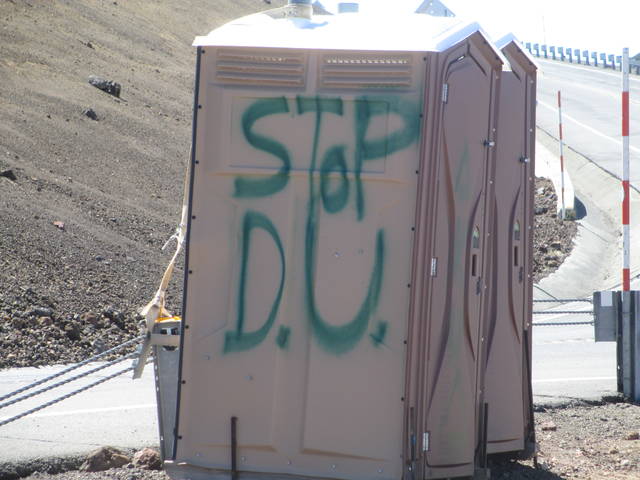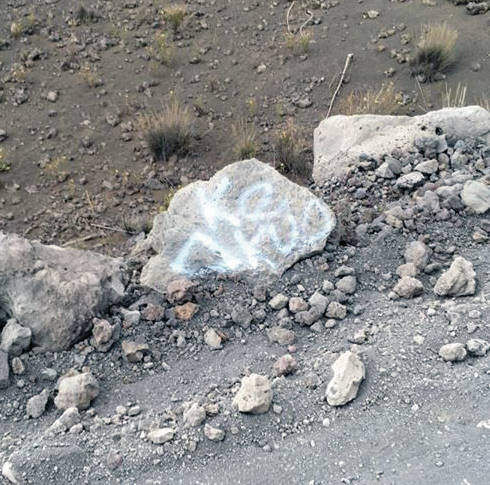KAILUA-KONA — Graffiti discovered on one of Hawaii’s most sacred mountains last month was geared toward protesting the military testing at Pohakuloa Training Area, officials speculated Monday.
KAILUA-KONA — Graffiti discovered on one of Hawaii’s most sacred mountains last month was geared toward protesting the military testing at Pohakuloa Training Area, officials speculated Monday.
Photos from the Department of Land and Natural Resources show the words “stop bombing” spray painted onto large boulders in the historic Ice Age Natural Area Reserve of Mauna Kea.
Along with the defaced rocks along the Mauna Kea Access Road, Mauna Kea property managed by the University of Hawaii was also tagged. School spokesman Daniel Meisenzahl said there were two to three areas tagged including a portable bathroom and parking stall.
Meisenzahl said it makes no sense for that kind of graffiti to be found on the Summit Access Road because it has nothing to do with Mauna Kea.
Eric Hamilton, spokesman at Pohakuloa, said those at the base are disgusted by the graffiti.
“It’s reprehensible,” he said. “It’s ironically stupid to say, ‘stop bombing’ then desecrate the aina in this way.”
According to a press release posted on DLNR’s Facebook page, the graffiti was found painted on the rocks at mid-morning of April 28.
“Due to the historical nature of this site, all geological features, including rocks, are protected under the Hawaii Administrative Rules,” the release states. “Additionally, the graffiti was found painted on various areas of Mauna Kea property managed by the UH Office of Mauna Kea Management.”
Lt. Col. Chris Marquez, garrison commander at Pohakuloa, said he first heard about the graffiti early Monday morning.
“Mauna Kea is not within our jurisdiction, and this is the first time we have heard of this type of intolerable desecration,” Marquez said.
He added they are not working with DLNR or the Office of Mauna Kea Management on this investigation.
“However, we do collaborate with them on cultural and natural resource initiatives, including the prevention of the spread of Rapid Ohia Death (ROD) on the island,” he said.
People first protested the military training exercises at the base in March. Some of the signs at the March 29 rally said, “end military pollution,” “stop bombing Hawaii, “stop live-fire ranges” and “Depleted uranium. Clean up your DUDU.”
Pohakuloa also provides fire and emergency services, including medical first responders and search-and-rescue operations on Mauna Kea for all 911 distress callers.
“We work diligently to protect the cultural sites at Pohakuloa Training Area (PTA),” Marquez said. “With a combined annual budget of over $5 million, PTA employs more than 50 individuals on its cultural and natural resources staff; this staff is dedicated to safeguarding cultural resources and preserving and protecting threatened and endangered plant and animal species.”
DLNR’s Division of Conservation and Resources Enforcement is investigating the taggings and asks for the public’s help in providing information related to this incident.
Anyone with information regarding this case is asked to call the Division of Conservation and Resources Enforcement Hawaii Branch Office at 933-3460 or call the DOCARE statewide hotline at 643-DLNR.
Meisenzahl said the graffiti was not be cleaned up until the investigation is complete.


